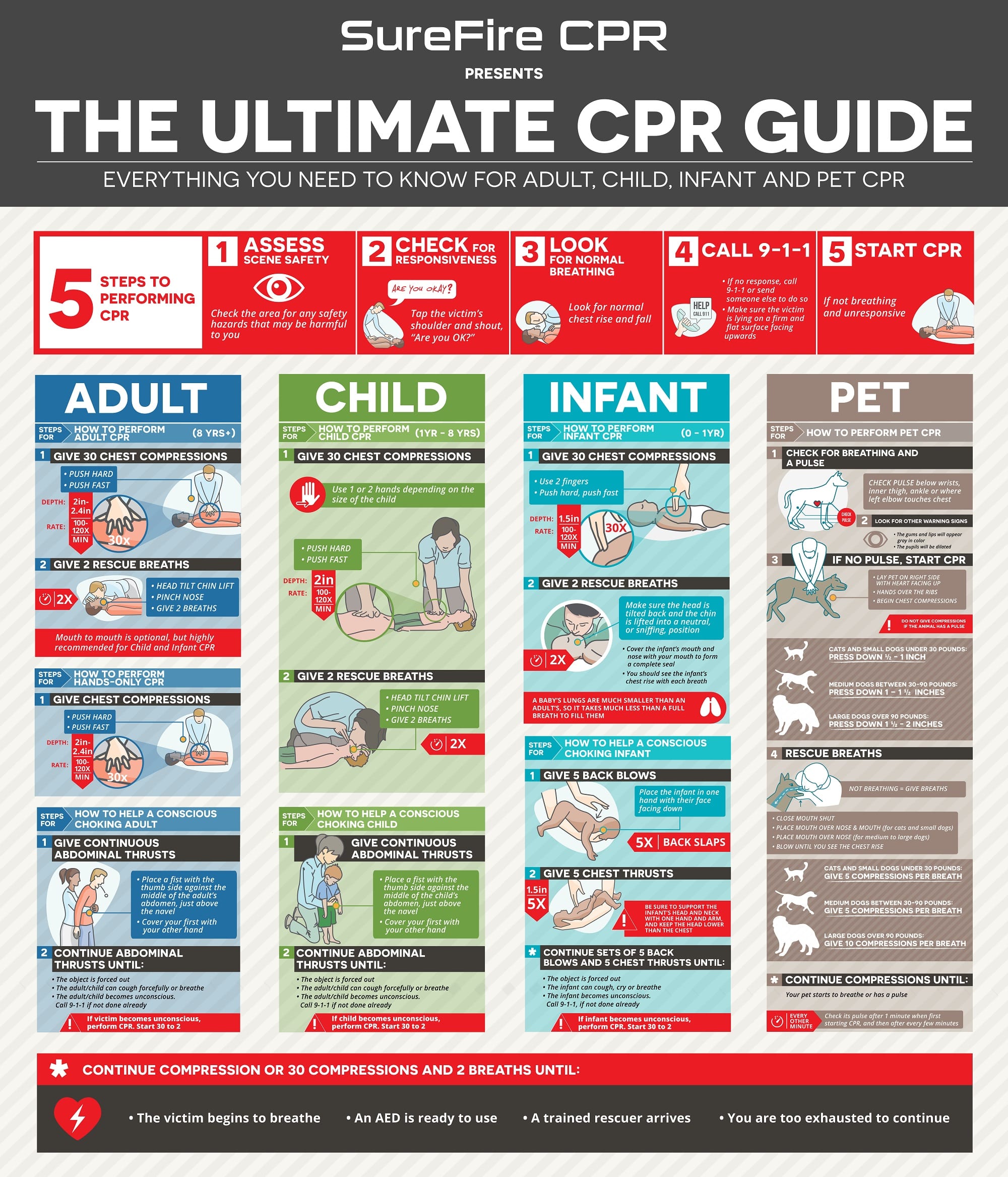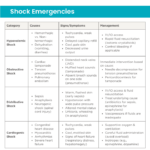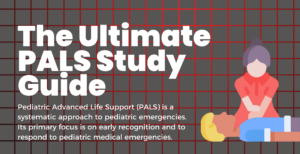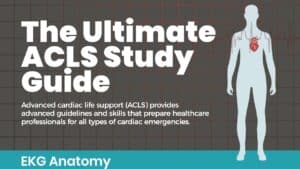Everything You Need to Know for Adult, Child, Infant and Pet CPR
5 Steps to Performing CPR:
- Assess Scene Safety
- Check the area for any saftey hazards that may be harmful to you.
- Check for Responsiveness
- Tap the victim’s shoulder and shout, “Are you OK”
- Look for Normal Breathing
- Look for Normal Breathing
- Call 9-1-1
- If no response, call 9-1-1 or send someone else to do so
- Make sure the victim is lying on a firm and flat surface facing upwards
- Start CPR
- If not breathing and unresponsive
Steps for How to Perform Adult CPR:
- Give 30 Chest Compressions
- Push down hard and fast in the middle of the chest, over the breastbone, with one hand on top of the other and fingers interlaced
- Press down 2-2.4 inches deep and at least 100-120 compressions per minute
- Allow for full chest recoil between each compression
- Give 2 Rescue Breaths
- Make sure the head is tilted back and the chin is lifted
- Pinch the nose shut and cover the victim’s mouth with your mouth to form a complete seal
- Blow inside the victim’s mouth for 1 second and check to see if the victim’s chest rises
- If their chest does not rise, give another breath
- Mouth to mouth is optional, but highly recommended for child and infant CPR
- Continue 30 Compressions And 2 Breaths Until
- The victim begins to breathe
- An AED is ready to use
- A trained rescuer arrives
- You are too exhausted to continue
- Special Considerations for Adult CPR
- Depending on the age of the Adult victim, the rescuer may fracture the sternum and/or ribs of the victim when performing CPR
- In order for CPR to be effective, the rescuer must push down hard, at least 2 inches deep, on the victim’s chest. Although, this pressure may do harm to the victim such as break bones. The decision to give CPR relies on the rescuer, but physicians suggest that the victim would most likely rather live with broken bones than not live at all
Steps for How to Help a Conscious Choking Adult:
- Give Continuous Abdominal Thrusts
- Place a fist with the thumb side against the middle of the child’s abdomen, just above the navel
- Cover your fist with your other hand
- Continue Abdominal Thrusts Until
- The object is forced out
- The adult/child can cough forcefully or breather
- The child becomes unconscious. Call 9-1-1 if not done already
Steps For How to Perform Child CPR (1yr-8yr):
- Give 30 Chest Compressions
- You can use one or two hands: For one-handed compressions, press down hard and fast on the center of the chest using the heel of your hand
- For two-handed compressions, push down hard and fast on the center of the chest with the heel of one hand and place the other over top
- Push down about 2 inches deep, giving at least 100 compressions per minute
- Allow for full chest recoil between each compression
- Give 2 Rescue Breaths
- Make sure the head is tilted back and the chin is lifted
- Pinch the nose closed and cover their mouth with your mouth to form a complete seal
- Blow inside the victim’s mouth for 1 second and look for their chest to rise
- If the chest doesn’t rise, give another breath
Steps on How to Help A Conscious Choking Child:
- Give Continuous Abdominal Thrusts
- Place a fist with the thumb side against the middle of the child’s abdomen, just above the navel
- Cover your fist with your other hand
- Continue Abdominal Thrusts Until
- The object is forced out
- The adult/child can cough forcefully or breather
- The child becomes unconscious. Call 9-1-1 if not done already
If child becomes unconscious, perform CPR. Start 30 to 2
Steps for How to Perform Infant CPR:
- Give 30 Chest Compressions
- Using two fingers, push down in the center of the chest, just below the nipple line
- Give 30 chest compressions at the rate of at least 100 per minute
- Press down approximately 1 1/2 inches deep
- Allow for full chest recoil between each compression
- Give 2 Rescue Breaths
- Make sure the head is tilted back and the chin is lifted into a neutral, or sniffing, position
- Cover the infant’s mouth and nose with your mouth to form a complete seal
- Give 2 rescue breaths, each 1 second long
- You should see the infant’s chest rise with each breath
- **A baby’s lungs are much smaller than an adult’s, so it takes much less than a full breath to fill them
Steps for How to Help a Conscious Choking Infant:
** The infant cannot cough, cry or breathe**
- Give 5 Back Blows
- Place the infant in one hand with their face facing down
- Give 5 firm back blows with the heel of one hand between the infant’s shoulder blades
- Give 5 Chest Thrusts
- Turn the infant over so their face is upwards in one arm with the same hand cupping their head
- Place two or three fingers in the center of the infant’s chest just below the nipples and press down onto the breastbone, about 1 1/2 inches deep – 5 Compressions
- **Be sure to support the infant’s head and neck with one hand and arm, and keep the head lower than the chest**
- Continue Sets of 5 Back Blows And 5 Chest Thrusts Until:
- The object is forced out
- The infant can cough, cry or breathe
- The infant becomes unconscious. Call 9-11, if not done already
Steps For How to Perform Pet CPR:
- Check For Breathing And a Pulse
- Using your middle and index fingers, check your pet’s pulse below its wrist, inner thigh, below the ankle, or where the left elbow touches the chest
- Check pulse below wrists, inner thight, ankle or where left elbow touches chest
- Look For Other Warning Signs
- The gums and lips will appear gray in color
- The pupils will be dilated
- If No Pulse, Start CPR
- Lay your pet on its right side, with its heart facing upwards
- Place your hands over the ribs where its elbows touches the chest
- Begin chest compressions (**DO NOT give compressions if the animal has a pulse)
- Cats and small dogs under 30 pounds: press down ½ – 1 inch
- Medium dogs between 30-90 pounds: press down 1 – 1 ½ inches
- Large dogs over 90 pounds: press down 1 ½ – 2 inches
- Rescue Breaths
- If your pet is not breathing, give rescue breaths
- Cats and small dogs: close your pets mouth shut, place your mouth over the nose and mouth, and blow until you see chest rise
- Medium to large dogs: close your pets mouth shut, place your mouth over the nose, blow until you see chest rise
- Cats and small dogs under 30 pounds: give 5 compressions per breath
- Medium dogs between 30-90 pounds: give 5 compressions per breath
- Large dogs over 90 pounds: give 10 compressions per breath
5. Continue Compressions And Breaths Until
- Your pet starts to breathe or has a pulse
- **Check its pulse after 1 minute when first starting CPR, and then after every few minutes











